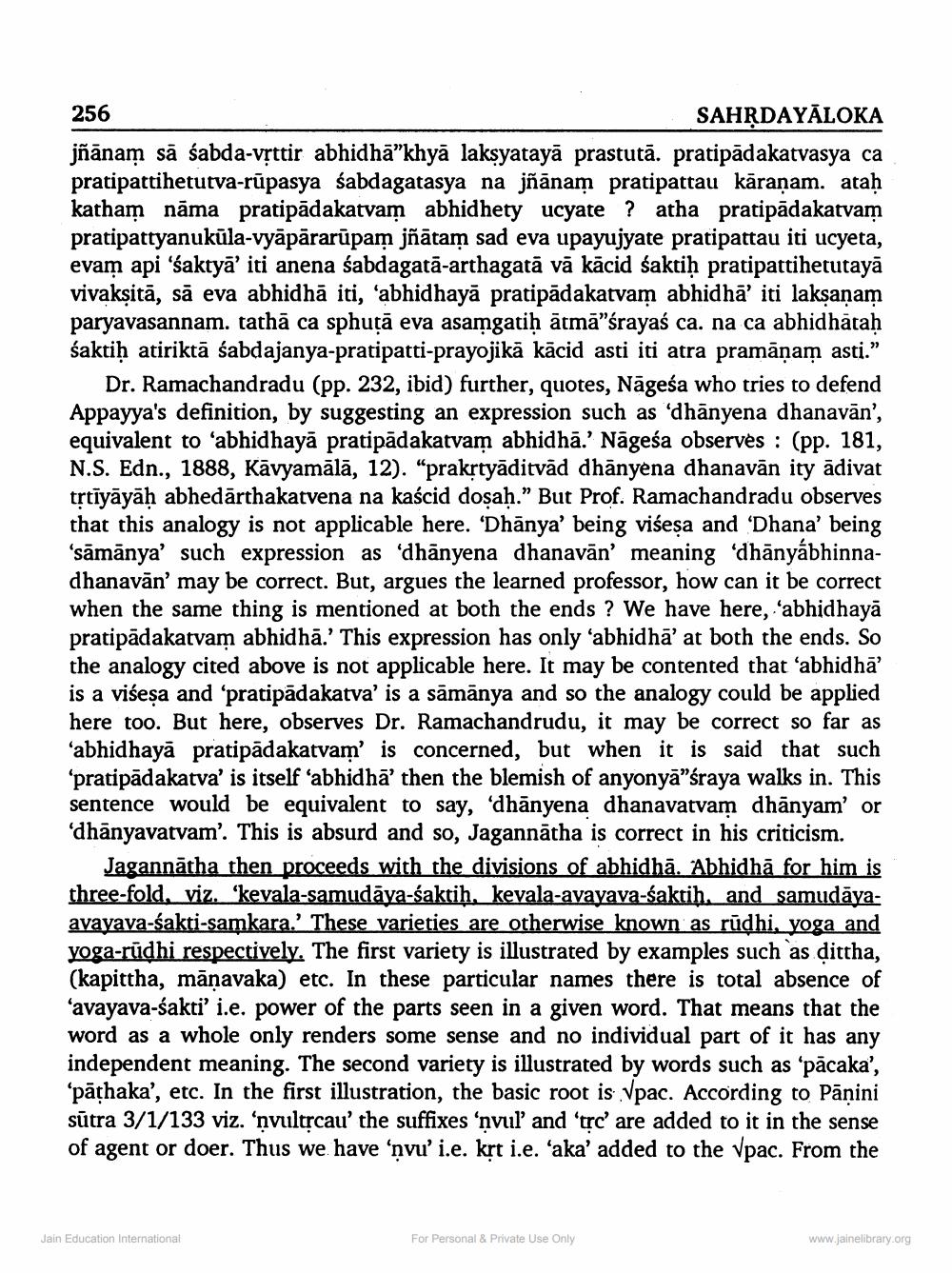________________
256
SAHRDAYĀLOKA jñānam sā śabda-víttir abhidhā”khyā laksyatayā prastutā. pratipādakatvasya ca pratipattihetutva-rūpasya śabdagatasya na jñānam pratipattau kāraṇam. ataḥ katham nāma pratipādakatvam abhidhety ucyate ? atha pratipādakatvam pratipattyanukūla-vyāpārarūpam jñātam sad eva upayujyate pratipattau iti ucyeta, evam api 'saktya' iti anena sabdagatā-arthagatā vā kācid śaktih pratipattihetuta vivakṣitā, sā eva abhidhā iti, ‘abhidhayā pratipādakatvam abhidhā' iti laksanam paryavasannam. tathā ca sphutā eva asamgatih ātmā”śrayaś ca. na ca abhidhātah śaktiḥ atiriktā sabdajanya-pratipatti-prayojikā kācid asti iti atra pramāņam asti."
Dr. Ramachandradu (pp. 232, ibid) further, quotes, Nāgeśa who tries to defend Appayya's definition, by suggesting an expression such as 'dhānyena dhanavān', equivalent to ‘abhidhayā pratipadakatvam abhidhā. Nāgeśa observes : (pp. 181, N.S. Edn., 1888, Kāvyamālā, 12). "prakrtyāditvād dhānyena dhanavān ity ādivat tỉtīyāyāḥ abhedārthakatvena na kaścid dosah.” But Prof. Ramachandradu observes that this analogy is not applicable here. 'Dhānya' being viśesa and 'Dhana' being 'sāmānya' such expression as 'dhānyena dhanavān' meaning 'dhānyábhinnadhanavān' may be correct. But, argues the learned professor, how can it be correct when the same thing is mentioned at both the ends? We have here, 'abhidhayā pratipadakatvam abhidhā.' This expression has only ‘abhidhā' at both the ends. So the analogy cited above is not applicable here. It may be contented that ‘abhidhā' is a viśesa and 'pratipādakatva' is a sāmānya and so the analogy could be applied here too. But here, observes Dr. Ramachandrudu, it may be correct so far as 'abhidhayā pratipādakatvam' is concerned, but when it is said that such 'pratipadakatva' is itself abhidhā' then the blemish of anyonya"śraya walks in. This sentence would be equivalent to say, 'dhānyena dhanavatvam dhānyam' or dhānyavarvam'. This is absurd and so, Jagannātha is correct in his criticism.
Jagannātha then proceeds with the divisions of abhidhā. Abhidhā for him is three-fold, viz. 'kevala-samudāva-saktih, kevala-avayava-saktih, and samudāyaavayava-śakti-samkara.' These varieties are otherwise known as rūdhi, yoga and yoga-rūdhi respectively. The first variety is illustrated by examples such as dittha, (kapittha, māņavaka) etc. In these particular names there is total absence of 'avayava-śakti' i.e. power of the parts seen in a given word. That means that the word as a whole only renders some sense and no individual part of it has any independent meaning. The second variety is illustrated by words such as 'pacaka', 'pāthaka', etc. In the first illustration, the basic root is Vpac. According to Pāṇini sūtra 3/1/133 viz. 'nvultặcau' the suffixes ‘nvul' and 'trc' are added to it in the sense of agent or doer. Thus we have ‘nvu' i.e. krt i.e. 'aka' added to the Vpac. From the
Jain Education International
For Personal & Private Use Only
www.jainelibrary.org




